
Lapparentosaurus is a genus of sauropod dinosaur from the Middle Jurassic. Its fossils were found in Madagascar. The type species is L. madagascariensis.
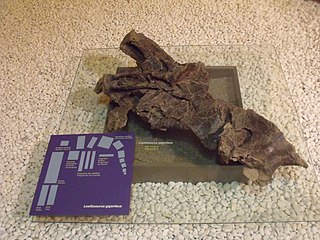
Losillasaurus is a genus of sauropod dinosaur from the Late Jurassic and possibly Early Cretaceous (Kimmeridgian-?Berriasian) in the southeast of Spain. The type species of the turiasaurian Losillasaurus giganteus was discovered in the Villar del Arzobispo Formation in Valencia and formally described by Casanovas, Santafé and Sanz in 2001. The holotype material is from a subadult and includes part of a skull; complete cervical, dorsal, sacral, and caudal vertebrae as well as several fragments; skeletal elements from the limbs including a humerus, ulna, radius, and metacarpal; sternal plates; and from the pelvis: the ilium, ischium, and pubis. The genus is characterized by the dimension and shape of the neural spine of the proximal caudal vertebrae. The humerus is 143 centimetres (56 in) long, which despite being from a subadult specimen is within 20% of the size of Paralititan. The size estimation proposed by Francisco Gascó in his master thesis is 15–18 m (49–59 ft) and 12-15 tons.

The blond capuchin is a species of the capuchin monkeys group, the genus Sapajus. This endangered species was rediscovered in 2006. It is endemic to northeastern Brazil.
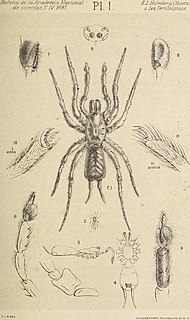
Dwarf tarantulas, also known as sheet funnel-web spiders are a type of spider from the family Mecicobothriidae. Dwarf tarantulas are one of several families of the suborder Mygalomorphae; this larger group also includes the true tarantulas.

Microstigmatidae is a small family of spiders with about 25 described species in eight genera. They are small ground-dwelling and free-living spiders that make little use of silk.
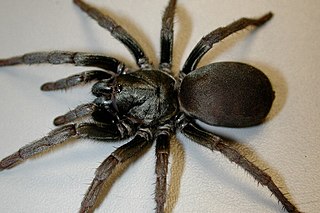
Nemesiidae, also known as funnel-web trapdoor spiders, is a family of mygalomorph spiders first described by Eugène Simon in 1889, and raised to family status in 1985. Before becoming its own family, it was considered part of "Dipluridae".
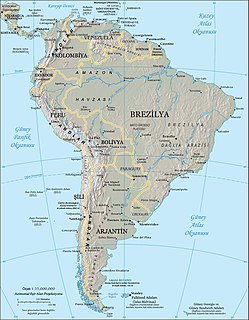
Oligoryzomys nigripes, also known as the black-footed colilargo or the black-footed pygmy rice rat, is a rodent in the genus Oligoryzomys of family Cricetidae. Oligoryzomys nigripes is a species that has been further divided into different sister taxa throughout history. It is found in different countries in South America. It is a large species with long ears, dark yellow to dark brown upperparts, sharply delimited from the whitish underparts, and often a pink girdle on the chest. This species of rat spends much of its life among the trees. The karyotype is 2n = 62, FNa = 78–82.

Ctenolepisma is a genus of primitive insects in the order Zygentoma, closely related to the silverfish and firebrat but less reliant on human habitation, some species being found both indoors and outdoors and some found exclusively outdoors. The genus is distributed nearly worldwide in warm regions. Australia lacks native Ctenolepisma, but is home to introduced species.
The genus Neacomys, also known as bristly mice because of their spiny fur, includes several species of rodents in the tribe Oryzomyini of family Cricetidae. It is most closely related to Oligoryzomys, Oreoryzomys, and Microryzomys. Neacomys species are mainly found in the Amazon basin, but N. pictus occurs in Panama and N. tenuipes in montane Colombia.

A caiman is an alligatorid belonging to the subfamily Caimaninae, one of two primary lineages within Alligatoridae, the other being alligators.

Onchopristis is a genus of extinct giant sclerorhynchoid from the Lower Cretaceous to Upper Cretaceous of North America, North Africa, Brazil, and New Zealand. It had an elongated snout lined laterally with barbed "teeth", or denticles.
Rafael Mendes Godoy is a six-time Brazilian Jiu Jitsu (BJJ) world champion at the black belt level. Rafael, along with his brother Guilherme, are 3rd degree black belts under Ramon Lemos and competitors for the Atos Jiu-Jitsu team.
Pedro Mendes may refer to:
Guilherme Mendes Godoy is a four-time Brazilian Jiu-Jitsu (BJJ) world champion at the black belt level. Guilherme along with his brother Rafael Mendes are 3rd degree black belts under Ramon Lemos, and competitors for the Atos Jiu-Jitsu team.

Shawn Peter Raul Mendes is a Canadian singer and songwriter. He gained a following in 2013, posting song covers on the video-sharing application Vine. The following year, he caught the attention of artist manager Andrew Gertler and Island Records A&R Ziggy Chareton, which led to him signing a deal with the record label. Mendes's self-titled debut EP was released in 2014, followed by his debut studio album Handwritten in 2015. Handwritten debuted atop the US Billboard 200, making Mendes one of five artists ever to debut at number one before the age of 18. The single "Stitches" reached number one in the UK and the top 10 in the US and Canada.
Thermobia aegyptiaca is a species of silverfish in the family Lepismatidae. The species was described by Hippolyte Lucas in 1840 based on specimens collected in Egypt. Thermobia aegyptiaca is distributed in Africa and the eastern Mediterranean Basin.
William Neil Eschmeyer, also known as Bill Eschmeyer, is an American ichthyologist. He is the founder and developer of the database and reference work Catalog of Fishes, hosted by the California Academy of Sciences and available both on-line and in print.
Macrostomus is a genus of flies in the family Empididae.
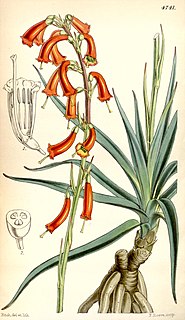
Agave coetocapnia is a species of flowering plant in the family Asparagaceae, native to Mexico. It was first described in 1824 as Bravoa geminiflora. It has been known by several other scientific names, including, in whole or part, Polianthes geminiflora. It has been cultivated as an ornamental plant.

Narindasaurus is a genus of turiasaurian sauropod dinosaur from the Middle Jurassic Isalo III Formation of Madagascar. The type species, N. thevenini was formally described by Royo-Torres et al. in 2020. The holotype, which consists of one specimen, is currently stored at the Muséum national d’Histoire naturelle and has been since 1906 or 1907.












